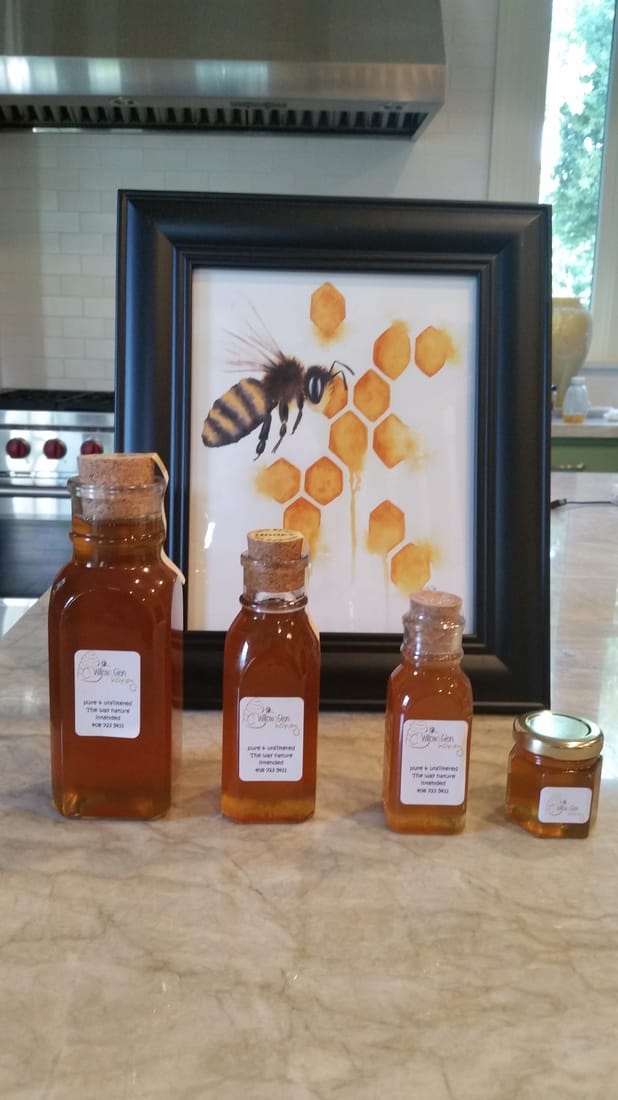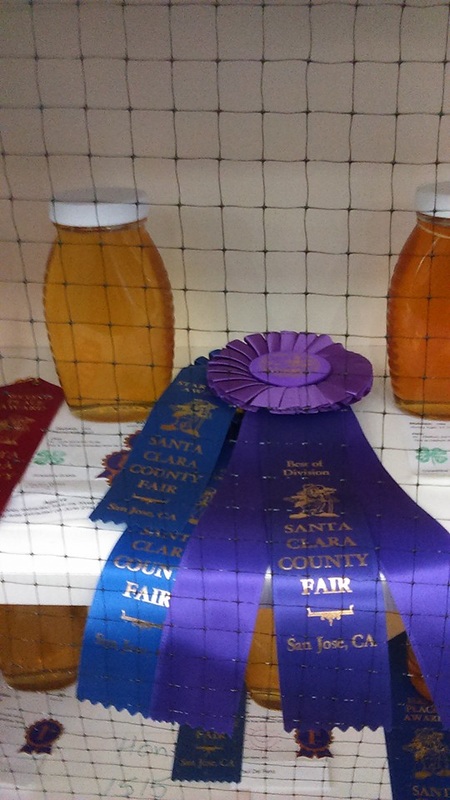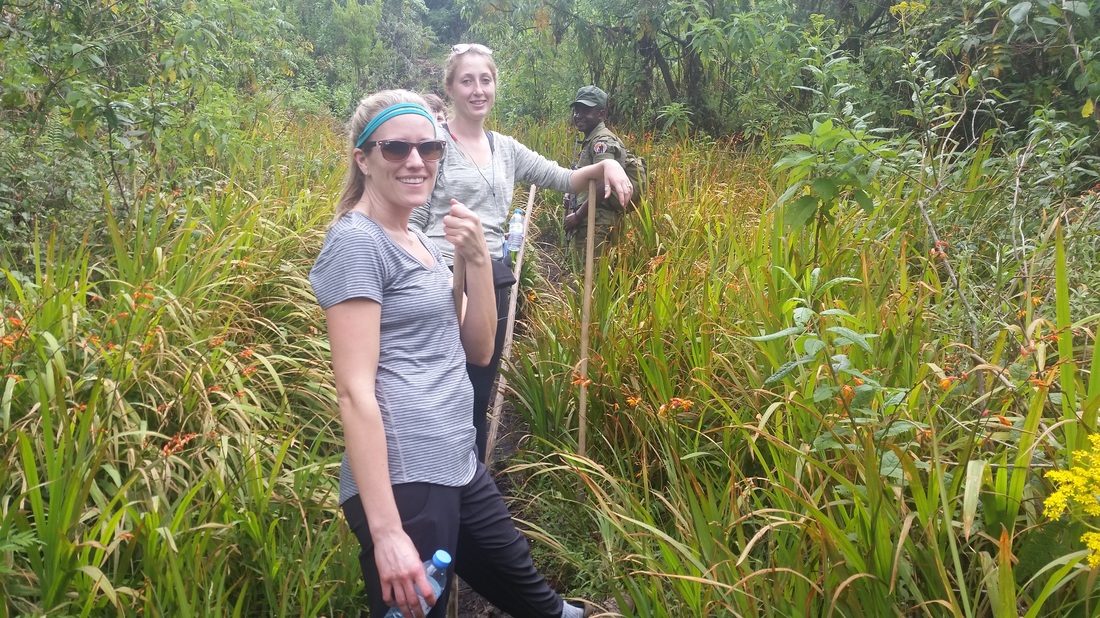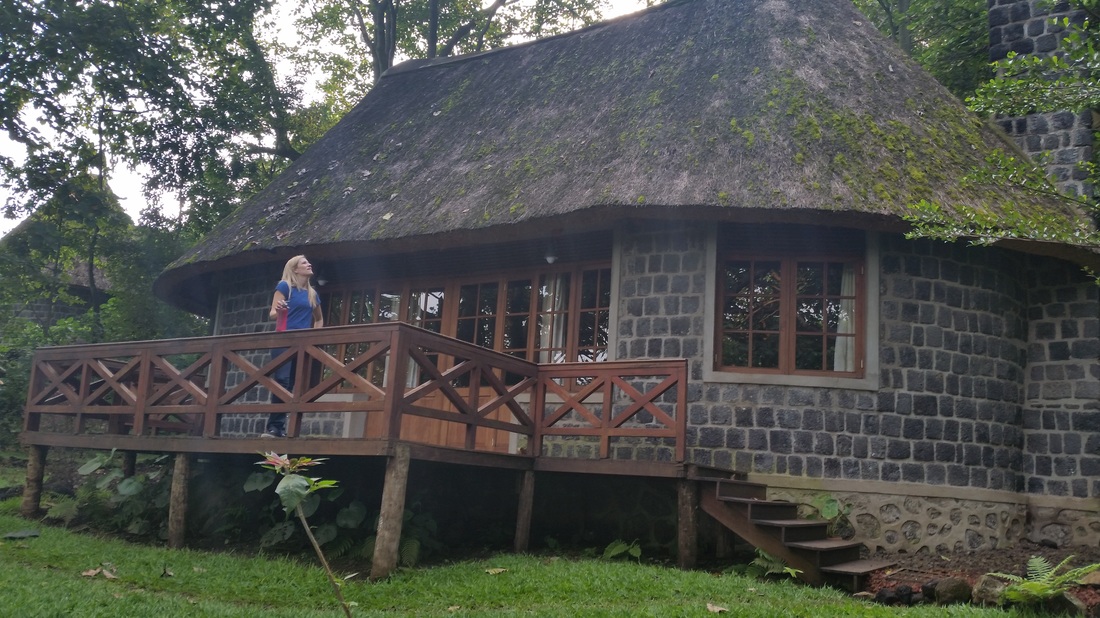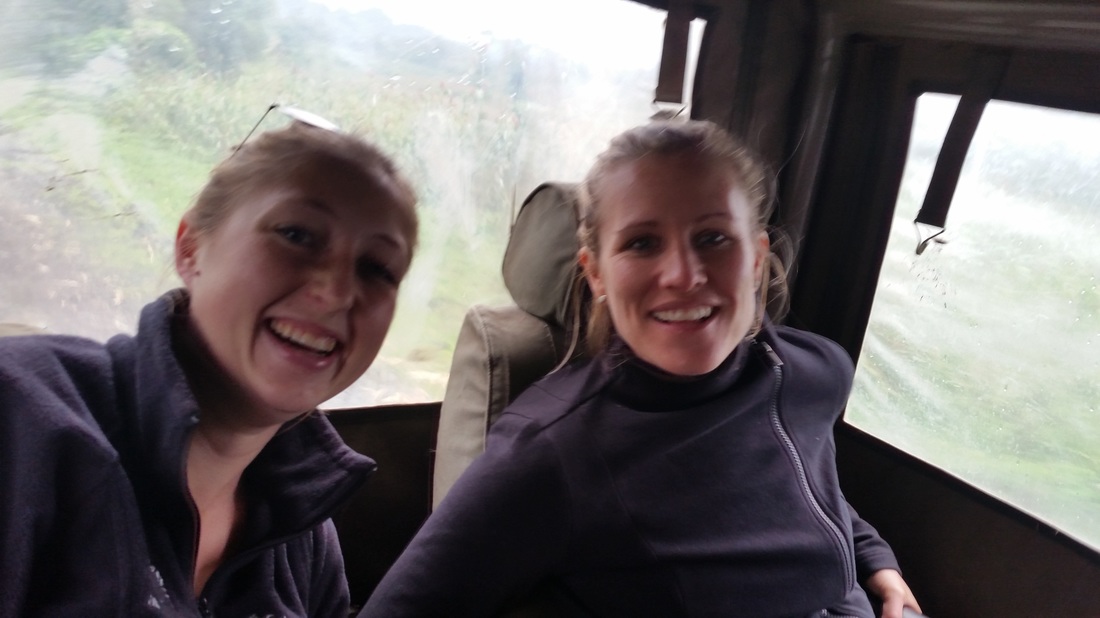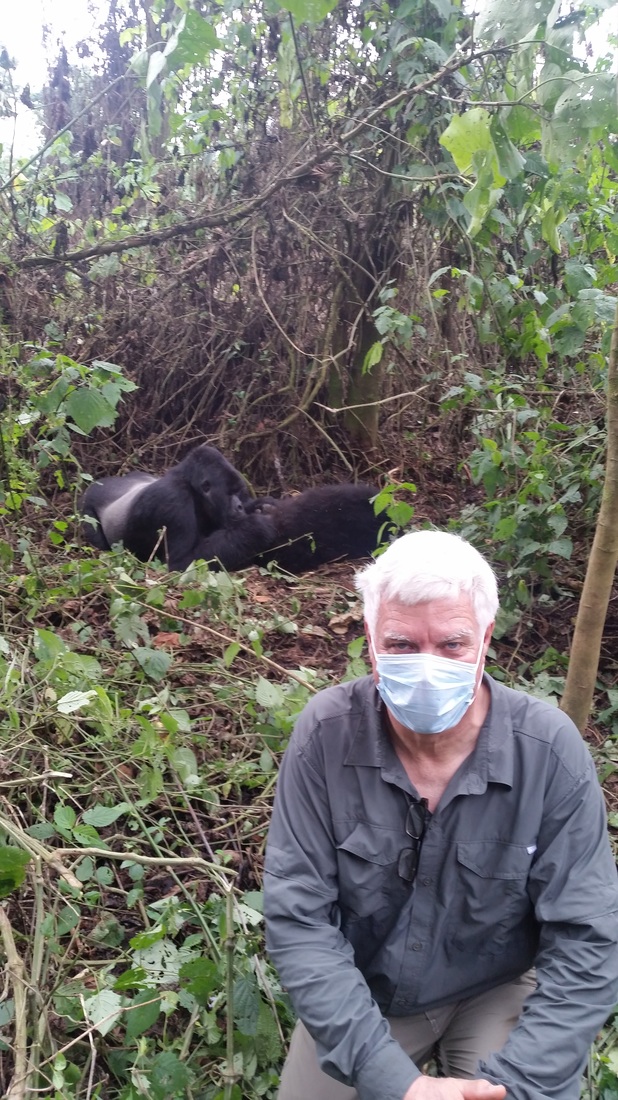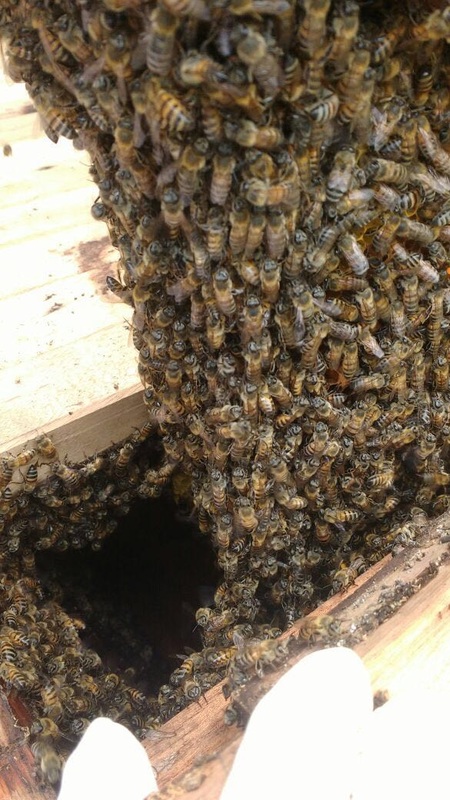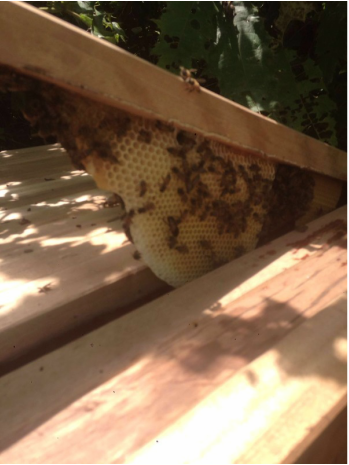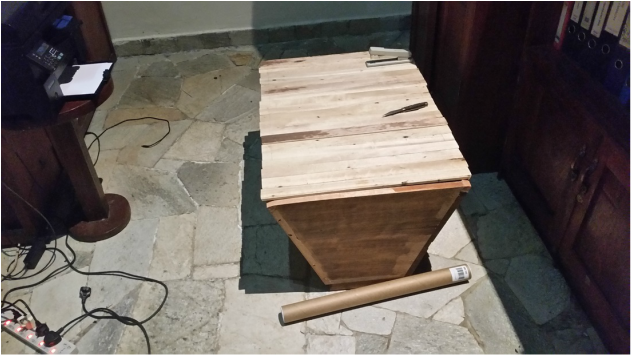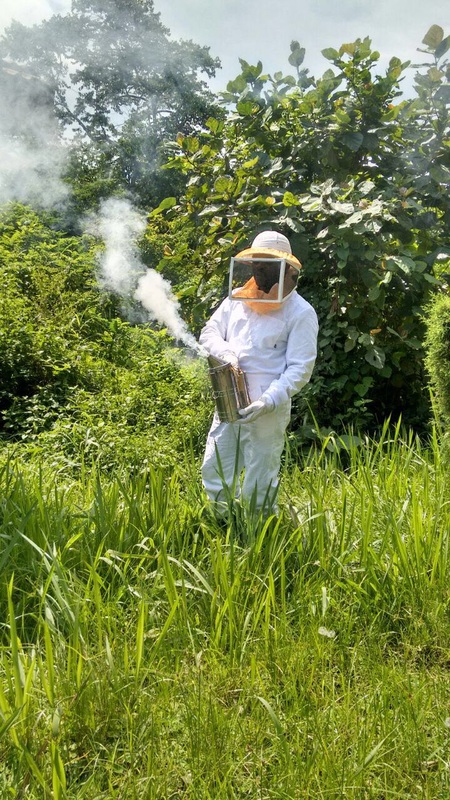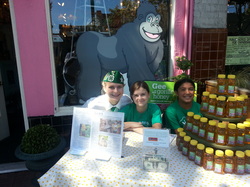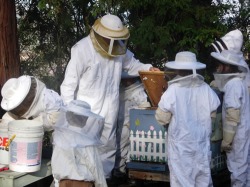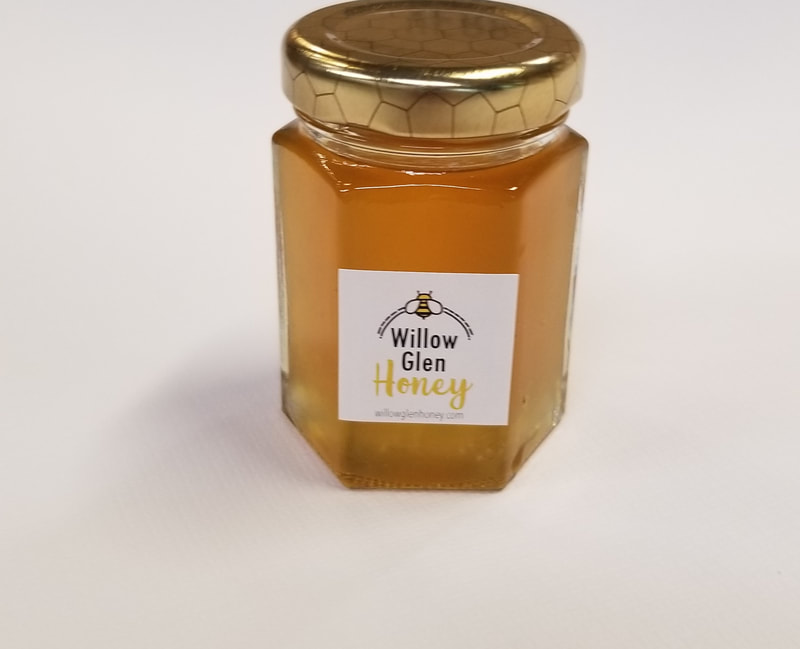| Willow Glen Honey |
|
Kristine Kruppa author of 27 Days to MIDNIGHT. On the edge of Nyiragongo volcano. Friends forever!
Park Ranger Gracien Muyisa Sivanza Our new bee keeper at the Mikeno Lodge
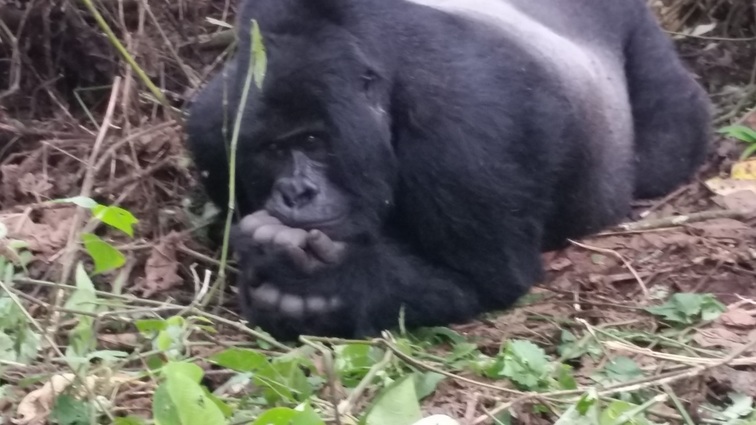
San Jose Mercury News June 2010
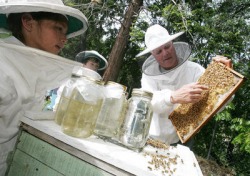
Steve Demkowski is the go-to guy in San Jose for bee swarms
San Jose Mercury News: www.Mercurynews.com
By Mary Gottschalk
[email protected]
Posted: 06/03/2010 08:06:45 PM PDT
Updated: 06/04/2010 01:44:01 PM PDT
http://www.mercurynews.com/cupertino/ci_15223529?nclick_check=1
Susan Ruscigno's neighborhood e-list message got right to the point: "Bees have invaded my orange tree - help!" Ruscigno's plea went on to describe how "hundreds of bees" had taken up residence in her backyard orange tree and she wanted them to leave.
"I'm all for Mother Nature and all, but the orange tree is right next to my back door, so I'm not thrilled to have them that close to my house (or me!) when I'm coming and going," she wrote.
Although it was a Sunday at 10:25 p.m. when she sent the e-mail out, within minutes fellow e-listers were responding and telling her to call "our local Steve Demkowski."
When it comes to bees, Demkowski is the go-to guy in the South Bay. He's usually the first person in my town that local schools, businesses and residents call when they encounter a swarm, and he's always happy to take a call because saving bees is his mission.
"One out of every three spoons of food that go into your mouth comes from bees," Demkowski says, pointing to fruits and vegetables as well as clover and alfalfa that feed cows needed to produce milk, yogurt and ice cream. Spring is a particularly busy time of year for Demkowski, as that is when many bees are swarming. "A swarm is the birth of a new hive. Like birds lay eggs, bees swarm," he says.
"The bees are doing what they've been doing for millions of years. It's really amazing; it's like you raising kids, getting them all raised, putting them through college and then you and your husband leave and let the kids have the house." Most swarms involve a queen bee that is leaving an existing hive, taking about 60 percent of the worker bees with her. However, before she leaves, she lays eggs in special "queen cups" so a new queen will emerge to continue the hive. Initially, swarms don't go far, as the queen needs to rest. Her worker bees join her as they wait for the scout bees to find them a new home.
It is during these swarming times that beekeepers like to collect.
"Usually they are there 12 hours or so and then they take off. You don't want to just let them go because they're going to go someplace and die. Even in the wild with holes in trees, it was hard for them; it's almost impossible now," Demkowski says.
If swarms go into walls and openings in houses, getting them out can cost several thousand dollars, he says.
In Ruscigno's case too much time lapsed between the time the swarm stopped in her orange tree and Demkowski's arrival the following afternoon.
"The bees up and left on their own, an hour before Steve arrived to collect them," Ruscigno says.
"He was very nice and he brought a jar of his honey, which was very good. I have told my neighbors and friends that if they ever find a swarm of bees in their tree to contact Steve."
When anyone calls about bees in a panic, Demkowski understands exactly how they feel because he felt that way a dozen years ago. "I had a swarm move into my back yard, and everybody panicked and I did the same thing," he says with a chuckle. "I ran into the house and got online and went to the University of Nebraska website, where I'm originally from. They said it was one of the safest times to be around honeybees when they're swarming. I read a little more and then I went back out.
"There were millions of these little fans flying around me, and they put out a scent that smells like lemon verbena, which is a pheromone telling the bees to stay together. "I've never seen a swarm that big since. I was out there and it was real calming. I just loved it." Demkowski's fascination did not wane. In fact he found himself reading more and more and within two years decided he wanted to be a beekeeper. "I got bee fever," he says. "I gave up golf. Beekeeping is my golf."
A commercial general contractor by occupation, Demkowski estimates he devotes from 20 to 30 hours a week to his avocation as Keeper of the Bees and president of Willow Glen Honey & Bees. "I handle all the swarm calls. I'll go out and pick them up on my way to work, on my way home and I'll do it until it's time for me to go to sleep," he says.
Additionally, Demkowski enjoys educating children about bees. He often visits kindergarten classes, and for the past eight years he's worked with 4-H members twice a month at History San Jose. "I teach about 20 to 25 children how to keep bees and most of them start off petrified of honeybees," he says.
"I have them paint their own hives, and we set them up. I teach them through the winter, and in the spring we put in packets of bees. Children love that part, but they like extracting honey the best."
All the honey they extract there is sold in the gift shop at History San Jose. Most recently, Demkowski built the observation hive at the new Happy Hollow Park & Zoo. A year ago Demkowski took care of close to 200 hives scattered around Willow Glen and other parts of Silicon Valley, but he lost 125 of those.
"It's called colony collapse disorder, and I'm thinking it's not just one thing," he says. "Everyone wants one simple solution, but it's a lot of different things." Demkowski believes part of it is the use of systemic pesticide that is pulled "up through the plant and kills aphids, but it kills honeybees, butterflies and hummingbirds. I haven't used any pesticides in my yard for at least 15 years."
This year, he says, he's got more than 100 operational hives, and he expects to add more as the bees continue to swarm. Last year he produced close to 3,000 pounds of honey, carefully noting on the labels where the honey is from. "If I take it from hives off of Bailey Road, I label it Bailey Road Honey," he says.
"Only honey collected in Willow Glen is labeled on the front and back as Willow Glen Honey. A lot of people bring honey to farmers' markets and if it's collected within 50 miles it's considered local, but my honey is from right here."
Demkowski sells his Willow Glen Honey at Three Sisters, 1393 Lincoln Ave. Demkowski is constantly asked if he's ever stung and he says he gets stung all the time. "When you work on their hive, you're supposed to smoke them and I get lazy and I get stung, or they'll crawl up my pant leg if I didn't tape my pants or they will get trapped behind my collar. "I get stung 20 times a week, but my bursitis is gone, my carpal tunnel is gone and I don't have arthritis." As for allergies, he says, "Everyone on earth is allergic to bees. You've got to get the stinger out as quickly as possible. The swelling is not dangerous."
Demkowski, who laughs about how hyper he is, says, "Bees really calm you down. They teach you to be calm, or they'll sting you. "If I get in a little tiff with my wife and I go outside, they can smell it and I'll get stung. You put off a smell. You have to be in a really good mood to be working on the bees.
"It's so neat. You can pet a bee in a flower and it's not going to sting you unless you grab or trap it somehow." For additional information on Steve Demkowski and beekeeping, visit www.willowglenhoney.com.
Celebrate Bees: Happy Hollow Park & Zoo
Happy Hollow Park Event Link: http://www.hhpz.org/index.cfm/id/22//EventID/C6C2E81C-C747-7102-338BD7FDCDBDB996/View/month/linkDate/June%207%2C%202010
Happy Hollow Park & Zoo celebrates National Pollinator Week with bee talks presented by resident beekeeper Steve Demkowski June 21 at 1 p.m., June 23 at 1 p.m. and June 24 at 1 p.m. Happy Hollow is home to a four-panel-high bee observation hive as well as two honeybee houses.
National Pollinator Week was officially declared by the U.S. Senate in 2007 to recognize the importance of pollinators to ecosystem health and agriculture and to increase awareness about pollinators.
URL Link to Article: http://www.mercurynews.com/cupertino/ci_15223529?nclick_check=1
San Jose Mercury News: www.Mercurynews.com
By Mary Gottschalk
[email protected]
Posted: 06/03/2010 08:06:45 PM PDT
Updated: 06/04/2010 01:44:01 PM PDT
http://www.mercurynews.com/cupertino/ci_15223529?nclick_check=1
Susan Ruscigno's neighborhood e-list message got right to the point: "Bees have invaded my orange tree - help!" Ruscigno's plea went on to describe how "hundreds of bees" had taken up residence in her backyard orange tree and she wanted them to leave.
"I'm all for Mother Nature and all, but the orange tree is right next to my back door, so I'm not thrilled to have them that close to my house (or me!) when I'm coming and going," she wrote.
Although it was a Sunday at 10:25 p.m. when she sent the e-mail out, within minutes fellow e-listers were responding and telling her to call "our local Steve Demkowski."
When it comes to bees, Demkowski is the go-to guy in the South Bay. He's usually the first person in my town that local schools, businesses and residents call when they encounter a swarm, and he's always happy to take a call because saving bees is his mission.
"One out of every three spoons of food that go into your mouth comes from bees," Demkowski says, pointing to fruits and vegetables as well as clover and alfalfa that feed cows needed to produce milk, yogurt and ice cream. Spring is a particularly busy time of year for Demkowski, as that is when many bees are swarming. "A swarm is the birth of a new hive. Like birds lay eggs, bees swarm," he says.
"The bees are doing what they've been doing for millions of years. It's really amazing; it's like you raising kids, getting them all raised, putting them through college and then you and your husband leave and let the kids have the house." Most swarms involve a queen bee that is leaving an existing hive, taking about 60 percent of the worker bees with her. However, before she leaves, she lays eggs in special "queen cups" so a new queen will emerge to continue the hive. Initially, swarms don't go far, as the queen needs to rest. Her worker bees join her as they wait for the scout bees to find them a new home.
It is during these swarming times that beekeepers like to collect.
"Usually they are there 12 hours or so and then they take off. You don't want to just let them go because they're going to go someplace and die. Even in the wild with holes in trees, it was hard for them; it's almost impossible now," Demkowski says.
If swarms go into walls and openings in houses, getting them out can cost several thousand dollars, he says.
In Ruscigno's case too much time lapsed between the time the swarm stopped in her orange tree and Demkowski's arrival the following afternoon.
"The bees up and left on their own, an hour before Steve arrived to collect them," Ruscigno says.
"He was very nice and he brought a jar of his honey, which was very good. I have told my neighbors and friends that if they ever find a swarm of bees in their tree to contact Steve."
When anyone calls about bees in a panic, Demkowski understands exactly how they feel because he felt that way a dozen years ago. "I had a swarm move into my back yard, and everybody panicked and I did the same thing," he says with a chuckle. "I ran into the house and got online and went to the University of Nebraska website, where I'm originally from. They said it was one of the safest times to be around honeybees when they're swarming. I read a little more and then I went back out.
"There were millions of these little fans flying around me, and they put out a scent that smells like lemon verbena, which is a pheromone telling the bees to stay together. "I've never seen a swarm that big since. I was out there and it was real calming. I just loved it." Demkowski's fascination did not wane. In fact he found himself reading more and more and within two years decided he wanted to be a beekeeper. "I got bee fever," he says. "I gave up golf. Beekeeping is my golf."
A commercial general contractor by occupation, Demkowski estimates he devotes from 20 to 30 hours a week to his avocation as Keeper of the Bees and president of Willow Glen Honey & Bees. "I handle all the swarm calls. I'll go out and pick them up on my way to work, on my way home and I'll do it until it's time for me to go to sleep," he says.
Additionally, Demkowski enjoys educating children about bees. He often visits kindergarten classes, and for the past eight years he's worked with 4-H members twice a month at History San Jose. "I teach about 20 to 25 children how to keep bees and most of them start off petrified of honeybees," he says.
"I have them paint their own hives, and we set them up. I teach them through the winter, and in the spring we put in packets of bees. Children love that part, but they like extracting honey the best."
All the honey they extract there is sold in the gift shop at History San Jose. Most recently, Demkowski built the observation hive at the new Happy Hollow Park & Zoo. A year ago Demkowski took care of close to 200 hives scattered around Willow Glen and other parts of Silicon Valley, but he lost 125 of those.
"It's called colony collapse disorder, and I'm thinking it's not just one thing," he says. "Everyone wants one simple solution, but it's a lot of different things." Demkowski believes part of it is the use of systemic pesticide that is pulled "up through the plant and kills aphids, but it kills honeybees, butterflies and hummingbirds. I haven't used any pesticides in my yard for at least 15 years."
This year, he says, he's got more than 100 operational hives, and he expects to add more as the bees continue to swarm. Last year he produced close to 3,000 pounds of honey, carefully noting on the labels where the honey is from. "If I take it from hives off of Bailey Road, I label it Bailey Road Honey," he says.
"Only honey collected in Willow Glen is labeled on the front and back as Willow Glen Honey. A lot of people bring honey to farmers' markets and if it's collected within 50 miles it's considered local, but my honey is from right here."
Demkowski sells his Willow Glen Honey at Three Sisters, 1393 Lincoln Ave. Demkowski is constantly asked if he's ever stung and he says he gets stung all the time. "When you work on their hive, you're supposed to smoke them and I get lazy and I get stung, or they'll crawl up my pant leg if I didn't tape my pants or they will get trapped behind my collar. "I get stung 20 times a week, but my bursitis is gone, my carpal tunnel is gone and I don't have arthritis." As for allergies, he says, "Everyone on earth is allergic to bees. You've got to get the stinger out as quickly as possible. The swelling is not dangerous."
Demkowski, who laughs about how hyper he is, says, "Bees really calm you down. They teach you to be calm, or they'll sting you. "If I get in a little tiff with my wife and I go outside, they can smell it and I'll get stung. You put off a smell. You have to be in a really good mood to be working on the bees.
"It's so neat. You can pet a bee in a flower and it's not going to sting you unless you grab or trap it somehow." For additional information on Steve Demkowski and beekeeping, visit www.willowglenhoney.com.
Celebrate Bees: Happy Hollow Park & Zoo
Happy Hollow Park Event Link: http://www.hhpz.org/index.cfm/id/22//EventID/C6C2E81C-C747-7102-338BD7FDCDBDB996/View/month/linkDate/June%207%2C%202010
Happy Hollow Park & Zoo celebrates National Pollinator Week with bee talks presented by resident beekeeper Steve Demkowski June 21 at 1 p.m., June 23 at 1 p.m. and June 24 at 1 p.m. Happy Hollow is home to a four-panel-high bee observation hive as well as two honeybee houses.
National Pollinator Week was officially declared by the U.S. Senate in 2007 to recognize the importance of pollinators to ecosystem health and agriculture and to increase awareness about pollinators.
URL Link to Article: http://www.mercurynews.com/cupertino/ci_15223529?nclick_check=1
San Jose Mercury News April 2010
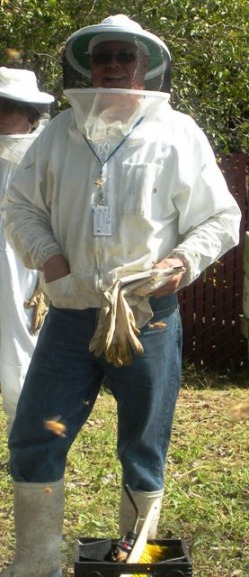
San Jose's Happy Hollow Park & Zoo retains vision from the ground up.
The Bee Guy
"Steve [Demkowski], the bee guy from Willow Glen [Honey], is doing this all on his own dime," Rogier says. "The area will be called the Backyard Habitat and will show how bees are beneficial to all of us. Steve is using cutting-edge technology and has been working with the San Diego Zoo to come up with innovative ways to keep the bees alive during the winter months."
- San Jose Mercury News
By Mayra Flores De Marcotte
[email protected]
Posted: 03/10/2010 06:01:37 PM PST
Updated: 03/11/2010 07:28:01 PM PST
The Bee Guy
"Steve [Demkowski], the bee guy from Willow Glen [Honey], is doing this all on his own dime," Rogier says. "The area will be called the Backyard Habitat and will show how bees are beneficial to all of us. Steve is using cutting-edge technology and has been working with the San Diego Zoo to come up with innovative ways to keep the bees alive during the winter months."
- San Jose Mercury News
By Mayra Flores De Marcotte
[email protected]
Posted: 03/10/2010 06:01:37 PM PST
Updated: 03/11/2010 07:28:01 PM PST
New Buzz ....Coming to a Zoo Near You!
New Observation Hive: March 20, 2010
Happy Hollow Park & Zoo
Come and visit our newest addition to the family at Happy Hollow Park & Zoo
Grand Re-Opening
Date: March 20, 2010
Time: 9:30 a.m. - Official Ribbon Cutting ceremony
10:00 a.m. - Gates Open to the New Happy Hollow Park & Zoo
Observation Hive Importance:
The mystery of what happens within a dark hive can be solved with an observation hive. Watching worker bees go about their business is fascinating. Observation hives serve several different purposes:
New Observation Hive: March 20, 2010
Happy Hollow Park & Zoo
Come and visit our newest addition to the family at Happy Hollow Park & Zoo
Grand Re-Opening
Date: March 20, 2010
Time: 9:30 a.m. - Official Ribbon Cutting ceremony
10:00 a.m. - Gates Open to the New Happy Hollow Park & Zoo
Observation Hive Importance:
The mystery of what happens within a dark hive can be solved with an observation hive. Watching worker bees go about their business is fascinating. Observation hives serve several different purposes:
- An observation hive can give you insight to the various things that are happening within a hive of bees.
- An observation hive can be used for demonstration if you give talks at school or fairs.
- An observation hive can help you study the habits of bees.
- An observation hive can be built larger to represent a normal hive of bees and studied year round.
http://www.hhpz.org/
1300 Senter Road
San Jose, CA 95112-2520
(408) 794-6400
40 Years of Celebrating Voluentarism
Junior League San Jose Honors Steve Demkowski with the VRL 2009 – Crystal Bowl
Volunteer Recognition Luncheon.
April 25th 2009
Junior League San Jose Honors Steve Demkowski with the VRL 2009 – Crystal Bowl
Volunteer Recognition Luncheon.
April 25th 2009
On April 25, 2009, the Junior League of San Jose was honored to host the 40th Anniversary of the
Volunteer Recognition Luncheon (VRL). Think back with us…what has happened in your life over the last
forty years? What has happened in our community over that last forty years? What opportunities have you had to serve in
our community over the last forty years? The Crystal Bowl Award Winners honored have taken their passion to serve
others and made a difference in the lives of those around them. They have assisted children, families, senior citizens, the
homeless, the hungry, and provided education to those in need.
Steve Demkowski - History San Jose
Yes - Steve is an expert on bees. No – he is not a professional beekeeper. Steve discovered his passion after confronting
a swarm in his own backyard. One thing lead to another and he’s now the resident expert at History San Jose
for their park bees, as well as being a guest speaker at many local elementary schools. He also gives talks to the
Professional Beekeeper Association. Steve’s enthusiasm and readiness to assist has brought numerous positive results to
not only History San Jose, but to hundreds of children who hopefully will continue to spread the news about the
fabulousness of bees.
Beauty and Barney Bee at History Park April 24th, 2009 — Education
Hi everyone,
Beauty and Barney Bee here! We’re fluffy Italian bees who live in a hive at History Park. We’re busy everyday flitting around the Park visiting all the lovely flowers in the flower gardens. Steve Demkowski our “keeper” makes sure we are well tended to by the 4-H children who work with him. They were out visiting us the other day making sure we would have enough food to hold us till more flowers and blossoms were out. Jane from the Junior League of San Jose even put on a bee keepers hat to film Steve and the children while they were feeding us – yum.
We also heard that because Steve has taken such good care of us and helped people learn more about how important we are, he is getting a Crystal Bowl award the Junior League Volunteer Recognition Luncheon today. We are very excited for him and for us. The whole hive is buzzing with the news.
Steve Demkowski and children feeding “hungry” bees after long winter.
Hi everyone,
Beauty and Barney Bee here! We’re fluffy Italian bees who live in a hive at History Park. We’re busy everyday flitting around the Park visiting all the lovely flowers in the flower gardens. Steve Demkowski our “keeper” makes sure we are well tended to by the 4-H children who work with him. They were out visiting us the other day making sure we would have enough food to hold us till more flowers and blossoms were out. Jane from the Junior League of San Jose even put on a bee keepers hat to film Steve and the children while they were feeding us – yum.
We also heard that because Steve has taken such good care of us and helped people learn more about how important we are, he is getting a Crystal Bowl award the Junior League Volunteer Recognition Luncheon today. We are very excited for him and for us. The whole hive is buzzing with the news.
Steve Demkowski and children feeding “hungry” bees after long winter.
“Hey Beauty, maybe we could hitch a ride in someone’s car up to the luncheon so we could see Steve get his award! We might even see ourselves in the video Jane took.”
“Oh Barney, people luncheons aren’t any fun for bees – we need to stay at the park to keep gathering the nectar from all the flowers and besides, we might get lost and not find our way back to History Park.”
“Say Beauty – maybe we should tell people about the fabulous honey Steve gathers from our hives.”
“That’s a good idea Barney – we could also tell them that the honey is sold in the Museum Store at History Park and they should start eating a spoonful each day to help prevent summer allergies.”
“Beauty that’s good information but I’m ready to get back to the hive.”
“Okay, Barney, maybe someone will have a question to ask us when they read about us.”
“Well, Beauty, I think we’ll be ready to answer all questions.”
“Oh Barney, people luncheons aren’t any fun for bees – we need to stay at the park to keep gathering the nectar from all the flowers and besides, we might get lost and not find our way back to History Park.”
“Say Beauty – maybe we should tell people about the fabulous honey Steve gathers from our hives.”
“That’s a good idea Barney – we could also tell them that the honey is sold in the Museum Store at History Park and they should start eating a spoonful each day to help prevent summer allergies.”
“Beauty that’s good information but I’m ready to get back to the hive.”
“Okay, Barney, maybe someone will have a question to ask us when they read about us.”
“Well, Beauty, I think we’ll be ready to answer all questions.”
Willow Glen High celebrates with homecoming parade, craft show
Lincoln Avenue sidewalks were rife with people on the morning of Saturday, Oct. 15. At about 9:30 a.m., a parade came down Lincoln from Willow past Minnesota. Besides typical floats and cars carrying the homecoming royalty, there were a couple of bands, a clown and a number of characters passing out candy.
The children were thrilled. Many of those attending took themselves off to the Farmers’ Market and out to breakfast after the parade. It was a lot of fun for everyone.
About an hour later, the high school held a craft show and before and during the game, people visited the booths. One was held by the high school and offered gold fish, some children went home very happy while their parents appeared kind of wary. Others offered unique designs. For example, Carolyn Ordinio, who lives in Willow Glen and Pam Pemberton, who was raised in Willow Glen, both work at the post office. Another unique booth was opened by Judy Maaggerise and Laurie Adams who offered pisque assette. The two women break up tiles and old dishes and glue them back together like a mosaic. They offered some really interesting pieces. Both women are from Willow Glen. They sell their wares at boutiques and craft shows.
Steve Demkowski from Willow Glen offered honey made by Willow Glen bees. The unprocessed and unfiltered honey smelled and tasted yummy. Demkowski, whose three children graduated from Willow Glen High, teaches bee keeping to others. He also sells bees wax and hand lotions made from the bees wax.
Lincoln Avenue sidewalks were rife with people on the morning of Saturday, Oct. 15. At about 9:30 a.m., a parade came down Lincoln from Willow past Minnesota. Besides typical floats and cars carrying the homecoming royalty, there were a couple of bands, a clown and a number of characters passing out candy.
The children were thrilled. Many of those attending took themselves off to the Farmers’ Market and out to breakfast after the parade. It was a lot of fun for everyone.
About an hour later, the high school held a craft show and before and during the game, people visited the booths. One was held by the high school and offered gold fish, some children went home very happy while their parents appeared kind of wary. Others offered unique designs. For example, Carolyn Ordinio, who lives in Willow Glen and Pam Pemberton, who was raised in Willow Glen, both work at the post office. Another unique booth was opened by Judy Maaggerise and Laurie Adams who offered pisque assette. The two women break up tiles and old dishes and glue them back together like a mosaic. They offered some really interesting pieces. Both women are from Willow Glen. They sell their wares at boutiques and craft shows.
Steve Demkowski from Willow Glen offered honey made by Willow Glen bees. The unprocessed and unfiltered honey smelled and tasted yummy. Demkowski, whose three children graduated from Willow Glen High, teaches bee keeping to others. He also sells bees wax and hand lotions made from the bees wax.
